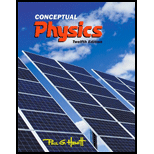
Concept explainers
The effect of incident light that falls on an object affect the motion of electrons in the atoms of the object
Answer to Problem 1RCQ
Solution:
The light incident on an object can be absorbed, reflected or transmitted by the electrons in the atoms of the object.
Explanation of Solution
When light with a certain frequency is incident on an object it can be absorbed, reflected or transmitted by the electrons in the atoms of the object. It depends on the
Sometimes an object may have several types of atoms having different natural frequencies. If Sunlight is incident on this type of object with many frequencies a range of frequencies may be absorbed by the object. The incident frequency which is not equal to the natural frequency of atoms in the object can be transmitted or reflected. When this frequency is incident the electrons begin to vibrate with small amplitude. If the object is transparent then this vibration energy is given to neighboring atoms and finally, a light wave is transmitted through the other side of the object. If the object is opaque, then the vibration energy cannot be shared with neighboring atoms and hence, the light is reflected through the incident side of the object.
Conclusion:
When light with many frequencies are incident on an object, some of them are absorbed by the object and the remaining are transmitted or reflected depending on the incident frequencies.
Want to see more full solutions like this?
Chapter 28 Solutions
Conceptual Physics (12th Edition)
 College PhysicsPhysicsISBN:9781305952300Author:Raymond A. Serway, Chris VuillePublisher:Cengage Learning
College PhysicsPhysicsISBN:9781305952300Author:Raymond A. Serway, Chris VuillePublisher:Cengage Learning University Physics (14th Edition)PhysicsISBN:9780133969290Author:Hugh D. Young, Roger A. FreedmanPublisher:PEARSON
University Physics (14th Edition)PhysicsISBN:9780133969290Author:Hugh D. Young, Roger A. FreedmanPublisher:PEARSON Introduction To Quantum MechanicsPhysicsISBN:9781107189638Author:Griffiths, David J., Schroeter, Darrell F.Publisher:Cambridge University Press
Introduction To Quantum MechanicsPhysicsISBN:9781107189638Author:Griffiths, David J., Schroeter, Darrell F.Publisher:Cambridge University Press Physics for Scientists and EngineersPhysicsISBN:9781337553278Author:Raymond A. Serway, John W. JewettPublisher:Cengage Learning
Physics for Scientists and EngineersPhysicsISBN:9781337553278Author:Raymond A. Serway, John W. JewettPublisher:Cengage Learning Lecture- Tutorials for Introductory AstronomyPhysicsISBN:9780321820464Author:Edward E. Prather, Tim P. Slater, Jeff P. Adams, Gina BrissendenPublisher:Addison-Wesley
Lecture- Tutorials for Introductory AstronomyPhysicsISBN:9780321820464Author:Edward E. Prather, Tim P. Slater, Jeff P. Adams, Gina BrissendenPublisher:Addison-Wesley College Physics: A Strategic Approach (4th Editio...PhysicsISBN:9780134609034Author:Randall D. Knight (Professor Emeritus), Brian Jones, Stuart FieldPublisher:PEARSON
College Physics: A Strategic Approach (4th Editio...PhysicsISBN:9780134609034Author:Randall D. Knight (Professor Emeritus), Brian Jones, Stuart FieldPublisher:PEARSON





